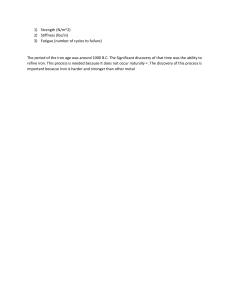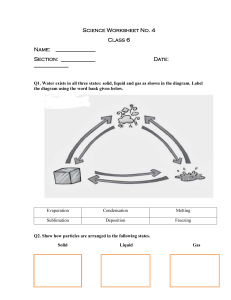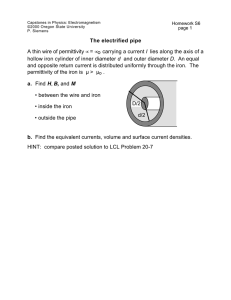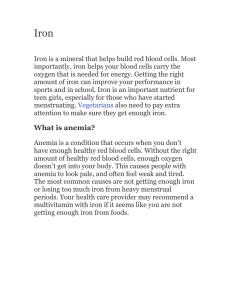Iron Deficiency Anemia: Causes, Stages, Diagnosis
advertisement
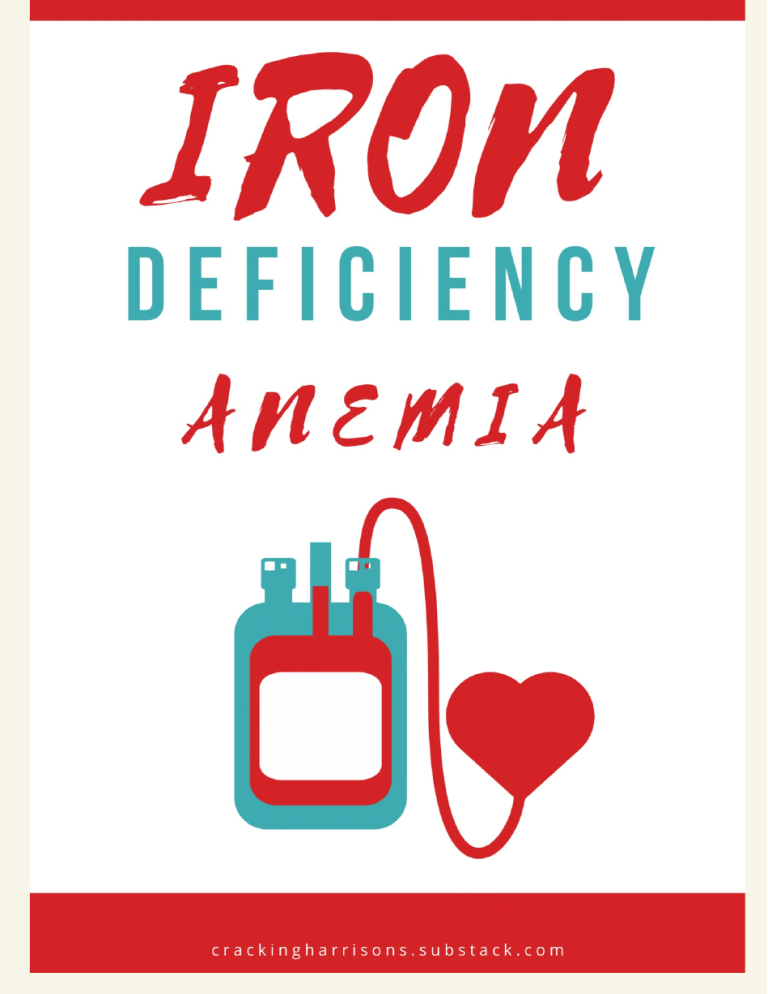
Chapter 93: Iron Deficiency Anemia www.crackingharrisons.com Page 683- 689 Hypoproliferative Anemias Recycling of Iron from senescent cells: - Hypoproliferative anemia: o most common anemia - When erythropoiesis is stimulated - Iron deficiency anemia o Most common type of Hypoproliferative anemia - Anemias associated with: o Normocytic and normochromic red cells o Reticulocyte index <2-2.5 - Categories of Hypoproliferative anemias o Early iron Deficiency (IDA) (before hypochromic & microcytic RBC develops) o Acute and chronic inflammation (including malignancies) o Renal disease o Hypometabolic states (protein malnutrition and endocrine diseases) o Anemia from marrow damage Iron Metabolism - Free iron o Highly toxic element o Is able to generate free radicals such as O2 or OH- Major role of iron o Carry oxygen as part of hemoglobin and myoglobin o Critical element in iron-containing enzymes (including cytochrome system) The iron cycle in humans - Transferrin o Is the iron transport protein o Carries 2 forms of Iron (monoferric and diferric) - As long as transferrin is maintained between: 20-60% and erythropoiesis is not increased o Use of iron stores is NOT REQUIRED - Transferrin-bound iron o Normal Half- Clearance time: 60-90 minutes o In IDA: Half- Clearance time: is 10-15 minutes o Normal turn over: 6-8 times per day o Clearance time is affected by: plasma iron level and erythroid marrow activity. There is an Increase in iron requirements when pool of erythroid cells increases Decrease of clearance time of iron from the circulation Formation of Iron-Transferrin complex Iron-Transferrin complex circulates in the plasma and binds with transferrin receptors Once binding occurs, complex is internalized via clathrin-coated pits and transported to an acidic endosome Iron is then released at an acidic pH Iron is made available for heme synthesis Transferrin-receptor complex: is recycled to the surface of the cell and later released back to the circulation In the erythroid cell: excess iron is stored as Ferritin In the liver parenchymal cells: iron becomes incorporated in heme-containing enzymes and stored Iron incorporated into hemoglobin (Hgb) enters the circulation as new RBC Iron that is part of red cell mass: not made available until red cell dies Once RBC becomes senescent: they are recognized by the reticuloendothelial system Red cell undergoes phagocytosis leading to Hgb breakdown Globin is returned to amino acid pool Iron is presented back to circulating transferrin Stimulation of erythropoiesis www.crackingharrisons.com PAGE 1 - Normal plasma iron level o 80-100 ug/dl - Transferrin receptors o Are located on the surface of merrow erythroid cells - Developing erythroblasts o The cell with the greatest number of receptors (300,000-400,000/cells) - Apoferritin + Excess Iron= Ferritin (storage form) - Average lifespan of RBC: 120 days o Reticuloendothelial system (RES) recognizes senescent RBC and is responsible for RBC phagocytosis - 1 ml of RBC contains o 1 mg of elemental iron - Amount of iron required from the diet to replace losses vary in sexes: o Men: 10% of body iron content per year o Women of child bearing age: 15% of body iron content per year - Dietary iron content o 6 mg of elemental iron per 1000 calories - Average iron intake and absorption o Male: 15 mg/d with 6% absorption o Female: 11 mg/d with 12% absorption o Individual with IDA: 20% absorption in meat containing diet o Vegetarian diet: 5-10% absorption - Substances in a vegetarian diet that reduces iron absorption o Phytates o Phosphates - During the last 2 trimesters of pregnancy: o Daily iron requirements: increase to 5-6 mg - Daily elemental iron needs o Adult male: 1 mg o Female in child bearing years: 1.4 mg/d Hemolytic anemia - Iron absorption takes place in the: o Duodenum o Proximal small intestine - Absorption of iron is facilitated by: o Acidic contents in stomach (maintains iron in solution) - Ferroportin o Is a membrane-embedded iron exporter o Function is regulated by hepcidin - Hepcidin o Is the principal iron regulatory hormone - Hephaestin: o Is responsible for oxidizing the iron to the ferric form for transferrin binding - IF delivery of iron to stimulated marrow is SUBOPTIMAL o Marrow proliferative response: blunted o Hemoglobin synthesis is impaired o Resulting to: Hypoproliferative marrow +Microcytic and Hypochromic anemia Nutritional Iron Balance - Routes of iron supplementation for the body: o Absorption from food and medicinal iron (PO) o Red cell transfusion o Ingestion of iron complexes - Factors that influence iron absorption o Erythroid hyperplasia: stimulates iron absorption (even in normal or increased iron stores and low hepcidin levels) - In patients with high levels of ineffective erythropoiesis o There is excess absorption of dietary iron o Molecular mechanism: production of erythroferrone (ERFE) by developing erythroblast ERFE suppresses hepcidin Increase absorption of dietary iron Leading to: iron overload and tissue damage www.crackingharrisons.com - - In patients with acute iron toxicity: due to ingestion of large number of iron tables 3. Iron Deficiency Anemia - Defined as: o Once transferrin saturation is <10-15% o In excessive intake of medicinal iron Percentage of iron absorbed decreases BUT absolute amount of iron goes up Amount of iron absorbed exceeds transferrin binding capacity of the plasma Increase of free iron in blood stream Leading to iron toxicity in critical organs such as cardiac muscle cells. - When iron stores are depleted (Serum ferritin <15 ug/L) o Serum Iron: falls o TIBC: increases o Red cell protoporphyrin: increases Anemia Iron Deficiency Anemia - 50% of anemia is attributed to iron deficiency - IDA o Most prevalent form of malnutrition Stages of Iron Deficiency Three stages of progression to iron Deficiency 1. Negative Iron Balance - Demands of iron exceed the body’s ability to absorb iron - Physiologic mechanism of this: o Blood loss o Pregnancy o Rapid growth spurts in adolescent o Inadequate dietary iron intake - In severe prolonged IDA: o Development of erythroid hyperplasia of the marrow Causes of Iron Deficiency - Blood Loss of 10-20 ml of RBC per day o Greater than the amount of iron that the gut can absorb from a normal diet - Iron stores or Ferritin levels o Low - Appearance of stainable iron on bone o Low - When Iron stores are still present: o Serum iron: normal levels o total iron-binding capacity (TIBC): normal levels o red cell protoporphyrin: normal levels o Red cell morphology: normal - As long as iron remains within normal limits: Hgb synthesis is unaffected 2. Period of Iron- Deficient Erythropoiesis - Defined as: o Once transferrin saturation is: 15-20% - There is impairment of Hgb synthesis - Peripheral blood smear (PBS): first appearance of microcytic cells - Presence of hypochromic reticulocytes Clinical Presentation of Iron Deficiency - IDA in adult male or post-menopausal female women means: o Gastrointestinal blood loss UNTIL proven otherwise - Usual signs of anemia o Fatigue o Pallor o Reduced exercise capacity - Signs of advanced tissue iron deficiency o Cheilosis (fissure at the corners of the mouth) o Koilonychia (spooning of the fingernails) www.crackingharrisons.com Laboratory Iron Studies Serum Iron and Total Iron Binding Capacity - Serum iron level o Represents: amount of circulating iron bound to transferrin o Normal range: 50-150 ug/dL o May have diurnal variation - TIBC o Indirect measure of the circulating transferrin o Normal range: 300-360 ug/dL - Transferrin saturation o Normal value: 25-50% o In IDA: <20% o In Tissue iron overload: >50% (disproportionate amount of iron bound to transferrin being delivered to nonerythroid tissues) o Formula: Serum Iron x100 divided by TIBC Serum Ferritin - In the cells o Iron is stored and complexed to proteins as ferritin or hemosiderin - Apoferritin o Binds to free ferrous iron and stores it in ferric form. As ferritin accumulates within the cells of RES Protein aggregates becomes hemosiderin - In states of blockage of release of iron from storage sites: o RE iron will be detected o Few or no Sideroblasts detected. - In myelodysplastic syndrome o Have mitochondrial dysfunction o (+) Ring Sideroblast: represents accumulation of iron in mitochondria that appears in a necklace fashion around the nucleus of the erythroblast. Red Cell Protoporphyrin Levels - Protoporphyrin o An intermediate in the pathway to heme synthesis o Normal value: <30 ug/dL of RBC o In IDA: >100 ug/dL - Increased protoporphyrin within RBC is seen in: o Impairment of heme synthesis - Most common causes that result in Increased protoporphyrin within RBC o absolute or relative iron deficiency o Lead poisoning - Increase protoporphyrin in RBC reflects: o Inadequate iron supply to erythroid precursors to support hemoglobin synthesis - Under steady state conditions o Serum ferritin levels correlate with total body iron stores Serum Levels of Transferrin Receptor Protein - Erythroid cells have highest number of transferrin receptors in the body - Serum ferritin: o most convenient test to estimate iron stores o Adult male normal level: 100 ug/L o Adult female normal level: 30 ug/L o Ferritin level <15 ug/L: diagnostic of absent body iron stores o Better indicator of iron overload compared to marrow iron stain - Serum Transferrin Receptor Protein (TRP) o Reflects the total erythroid marrow mass o Normal values: 4-9 ug/L Evaluation of Bone Marrow Iron Stores - RE iron stores: o Estimated by iron staining of bone marrow aspirate or biopsy - Marrow iron staining o Provides information about the effective delivery of iron to developing erythroblast - Condition that has elevated serum TRP o Absolute Iron Deficiency Differential Diagnosis - Differential diagnosis for hypochromic microcytic anemia: o IDA o Thalassemia o Anemia of Inflammation aka Anemia of chronic disease o Myelodysplastic Syndromes o Sideroblasts: are 20-40% of developing erythroblasts that have visible ferritin granules o Ferritin granules: represent iron in excess that is needed for hemoglobin synthesis www.crackingharrisons.com Treatment of IDA - Severity and cause of IDA: determines the approach to patient - Elderly with severe IDA and cardiovascular instability o RBC transfusion - Younger patients that can compensate for their anemia o Iron replacement - For unusual blood loss or malabsorption o Do specific tests www.crackingharrisons.com Red cell transfusion - Reserved for individuals who have: o Symptoms of anemia o Cardiovascular instability o Continued and excessive blood loss - Corrects anemia acutely - Transfused RBC provide iron source for reutilization - Iron Tolerance test o Test done in the clinic to determine patient’s ability to absorb iron o Procedure: 2 Iron tablets are given on an empty stomach and serum iron is measured serially over 2-3 hours o Normal absorption will result in: Increase in the serum iron of at least 100 ug/dL - If IDA persist despite adequate treatment o May be necessary to switch to parenteral therapy Oral iron therapy - Reserved for the following patients o Established IDA o Intact gastrointestinal tract - Ascorbic acid o Enhances iron absorption - Daily dosing: o 200 mg of elemental iron per day o 200 mg of elemental iron per day, only has iron absorption up to 50 mg/day o About 3-4 iron tablets containing 50-65 mg elemental iron o Should be taken on an empty stomach - Patients who with gastric disease or prior gastric surgery: o Needs special treatment with iron solution o These subsets of patients have reduced retention capacity of the stomach that is necessary to dissolve the shell of the iron before iron release Parenteral Iron therapy - Given to patients: o unable to tolerate oral therapy o Needs are relatively acute o Who need iron on an ongoing basis o Due to persistent GI or menstrual blood loss - Erythropoietin (EPO) therapy o Induces a large demand for iron that cannot be met by physiologic release of iron from RE source or oral iron absorption o Needs adjunct Parenteral iron therapy - Goal of therapy in IDA o Repair the anemia o Provide iron stores of at least 0.5-1 gram of iron - Sustained treatment for IDA: o Continuing for 6-12 months after correction of anemia may be necessary to provide the iron stores of 0.5-1 gram of iron. - Complications of oral iron therapy: o Gastrointestinal distress: most common & seen in 15-20% of patients Abdominal pain, nausea, vomiting or constipation: leads to non-compliance - Response to iron therapy o Reticulocyte count begins to increase within 4-7 days after initiation of therapy o Reticulocyte count increase peaks at 1-1/2 weeks post initiation - Parental Iron is used in two ways: o Administer the total dose of iron required to correct the hemoglobin deficit and provide patient with at least 500 mg of iron stores o Give repeated small doses of parenteral iron over a protracted period (in dialysis centers) - In dialysis centers: o Give 100 mg of elemental iron to be given weekly for 10 weeks to augment the response of recombinant EPO - Formula used to calculate the amount of iron needed by patients o Body weight (kg) x 2.3 x (15-patient’s Hgb, g/dL) +500 or 1000 mg (for stores) - Absence of response to iron therapy o Due to poor absorption o Non compliance o Confounding diagnosis www.crackingharrisons.com - Side effects: o Anaphylaxis: much rarer in new formulations o Arthralgias, skin rash and low-grade fever: appears after several days after infusion of a large dose of iron; dose related side effect - To prevent side effects of giving large dose (>100 mg) of LMW iron dextran o Dilute the iron preparation in 5% dextrose in water or 0.9% NaCl solution o Iron solution be infused over a 60-90 minute period o Give test dose of 25 mg of parenteral LMW iron dextran o If presence of chest pain, wheezing, a fall in BP: stop iron transfusion Other Hypoproliferative anemias - Hypoproliferative anemias can be divided into 4 categories o Chronic inflammation o Renal Disease o Endocrine and nutritional deficiencies (hypometabolic states) o Marrow damage - Pathophysiology underlying the Hypoproliferative anemias: o Inadequate endogenous EPO production: chronic inflammation, renal disease or hypometabolism o Inadequate response of erythroid marrow to stimulation due to defective iron reutilization: anemia of chronic inflammation - When there is inadequate endogenous EPO production o Results in polychromatophilic “shift” reticulocyte seen in the peripheral blood smear Anemia of Acute and Chronic Inflammation/ Infection (AI) - Includes the following conditions: o Inflammation o Infection o Tissue Injury o Cancer- releases proinflammatory cytokines - Serum ferritin values o Most distinguishing feature: typically, serum ferritin values increase threefold over basal levels in the face of inflammation - Changes seen in AI is due to: o Inflammatory cytokines and hepcidin o IL-1: decreases EPO production in response to anemia o TNF: suppresses the response of bone marrow to EPO o Hepcidin is increased and is made by the liver via IL-6 mediated pathway o Hepcidin: suppress iron absorption and iron release from storage sites. - With chronic inflammation: Primary disease will determine the severity and characteristics of anemia o Cancer: normocytic and normochromic, Hypoproliferative marrow o Longstanding and active rheumatic arthritis and TB: microcytic and hypochromic anemia, Hypoproliferative marrow - With acute inflammation o Have a decrease in Hgb level of 2-3 g/ dL within 1 or 2 days: due to hemolysis o Fever and cytokines: exert pressure on RBC limited capacity to maintain red cell membrane hemolysis of RBC - In patients with preexisting cardiac disease: Moderate anemia Hgb 10-11 g/dl associated with o Angina o Exercise intolerance o Shortness of breath Anemia of Chronic Disease (CKD) - Associated with moderate to severe hypoproliferative anemia - Level of anemia correlates with the stage of CKD - Due to: o the failure of EPO production by the diseased kidney o Reduction in red cell survival - In patients with hemolytic-uremic syndrome o Have increased erythropoiesis in response to hemolysis (despite renal failure) - In patients with polycystic kidney disease o Have a smaller degree of EPO deficiency for a given level of renal failure - In patients undergoing chronic hemodialysis o Iron must be replenished: to ensure adequate response to EPO www.crackingharrisons.com Anemia in Hypometabolic States - Seen in patients with: o Starvation states and protein deficiency o Endocrine disorders that produce lower metabolic rates (hypothyroidism) - EPO production is triggered by: lower levels of blood oxygen content in disease states In Endocrine deficiency states - Difference in levels of Hgb between men and women is due to: o Effects of androgen and estrogen on erythropoiesis - Factors that decrease erythropoiesis: o Castration o Estrogen administration to males - Development of mild anemia is due: o Nutritional deficiencies because iron and folic absorption is affected in hypothyroid and patients with deficiency in pituitary hormone o Anemia is corrected when hormone deficiency is corrected - In Addison’s disease o Anemia may be more severe o Severity of anemia depends on: level of thyroid and androgen hormone dysfunction o Anemia may be masked by decreases in plasma volume o Once patients are given cortisol and volume replacement: this leads to fall in Hgb - In hyperparathyroidism, mild anemia is due to o Decreased EPO production as a renal effect of hypercalcemia o Impaired proliferation of erythroid progenitors Anemia in liver disease - Have mild hypoproliferative anemia - Peripheral blood smear shows: spur cells and stomatocytes o Spur cells and stomatocytes are from the accumulation of excess cholesterol in the membrane o Accumulation of cholesterol in the membrane is due to: deficiency of lecithincholesterol acyltransferase - Red cell survival: shorted o Production of EPO is inadequate to compensate for this - Associated nutritional deficiencies: o Folate deficiency: inadequate intake o Iron deficiency: due to blood loss and inadequate intake Anemia of aging - Common in people over 65 years old - Patients with unexplained anemia of aging DO NOT HAVE o Nutritional deficiency o Renal dysfunction - Older people have increased cytokines (inflammation of aging) o but not high enough to mimic anemia of chronic inflammation - Probable underlying pathophysiology of anemia of aging Decrease red cell survival in older people EPO is in a normal range, which is inappropriately low for the Hgb levels In protein starvation - Decreased dietary intake of protein o Leads to: mild to moderate hypoproliferative anemia (seen in elderly) o Anemia is more severe in patients with greater degree of starvation - In Marasmus o Patients have both protein and calorie deficiency o The degree of impaired release of EPO is proportion to the reduction of metabolic rate o Degree of anemia is masked by: volume depletion o Degree of anemia becomes apparent after: refeeding o Changes in RBC indices on refeeding should prompt evaluation of iron, folate and B12 status www.crackingharrisons.com Treatment for Hypoproliferative Anemia - Reversal of hypoproliferative anemia is not possible in the following diseases o End stage kidney disease o Cancer o Chronic inflammatory diseases Transfusion - Threshold of transfusion is based on patient’s symptoms o NO cardiovascular or pulmonary disease: <7-8 mg/dl o With physiologic compromise <10 g/dl - 1 unit of PRBC o Increases hemoglobin by 1 g/dL - Darbepoetin alfa o a longer preparation of EPOreduces frequency of injection o a molecularly modified EPO with additional carbohydrate o Half-life: 3-4 times longer than recombinant human EPO o Dosing: May be given weekly or every other week - Oral EPO mimetics o Increases the biological half-life of active hypoxia-induced factor (HIF) o Shown to increase Hgb in patients with CKD - Associated with: o Infectious risk o Iron over load (in chronic transfusion) Erythropoietin - Given when endogenous EPO level is inappropriately low (CKD or AI) - Iron status should be evaluated o Iron replacement should be given: to attain optimal effects from EPO - In CKD patients o EPO is given: 50-150 U/kg three times a week IV o 90% of patients respond to EPO o Hemoglobin levels of 10-12 g/dL are reached within 4-6 weeks - A decrease in Hgb level in the face of EPO therapy means: o Infection o Iron depletion - Factors that can compromise the response to EPO o Aluminum toxicity o Hyperparathyroidism - During Infection: o Stop EPO therapy o Rely on transfusion to correct anemia UNTIL infection is treated - To correct chemotherapy- induced anemia in cancer patients o EPO: 300 U/kg three times a week o Only 60% of patients responds to EPO - Various risks associated with EPO administration o Thromboembolic complication o Tumor progression www.crackingharrisons.com
